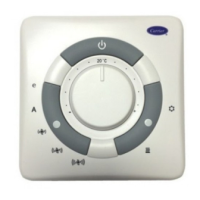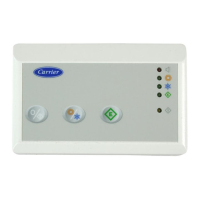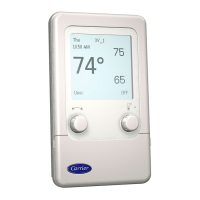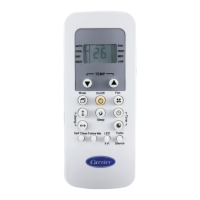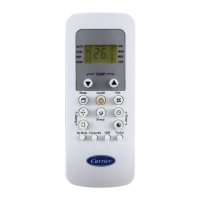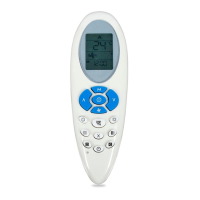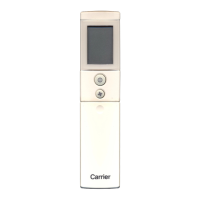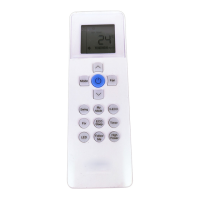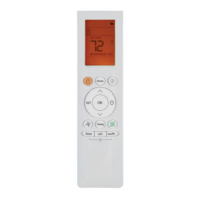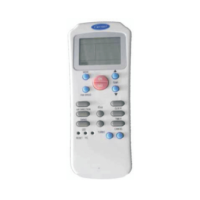Use the SCROLL UP/DOWN buttons or the NAVIGATE
knob to scroll through the screen data. Press the SELECT
button to modify the highlighted line. For Bus Number.
Element Number. and Baud Rate, use the INC/DEC buttons or
the MODIFY rotmy knob to adjust the highlighted value. For
the controller nmne, description and reference, the System Pilot
will highlight the first ASCII charactel: Use the NAVIGATE
knob to move to the left or right within the field. Use INC/DEC
or the MODIFY rotary knob to adjust the highlighted chamctel:
Pressing the EXIT button causes the System Pilot to return to
the Program screen.
ALARM HIST -- Selecting the ALARM HIST option fiom
the Program screen displays the Alarm History screen. See
Fig. 16. This screen shows the most recent alarms and alerts
generated by the attached device and stored in its Alarm
History table.
The top line shows the 8-character device name. The middle
of the screen shows the alarms/alelts, displayed one at a time.
The bottom line shows the current alarm number and the
number of alarms in the table. This line may also display error
messages as applicable.
Use the SCROLL UP/DOWN or PAGE UP/DOWN
buttons or the NAVIGATE knob to scroll through the ahums/
alerts one at a time. If the EXIT button is pressed, the System
Pilot will return to the Program screen.
TIME/DATE- Selecting the TIME/DATE option from the
Program screen displays the Time and Date screen shown in
Fig. 17. This screen shows the day-of-week, time, holiday flag
and date of the attached device.
The top line shows the 8-character device name. The
bottom line shows any text and error messages, as applicable.
All of the fields in the center portion of the screen (Day of
Week, Time, etc.) can be modified.
Attach to Controller
Default 0 12
CTRL1 1 7
NII-'II_ N0] i N
CTRL3
0 125
0 0
0 0
<Text & Error messages>
Fig. 13 -- Attach Screen
(System Pilot on Carrier Communicating Network)
Attach to Controller
Default 0 12
_."t_,,_]Id]![o]iil P.,gt_l
<Text & Error messages>
Fig. 14 -- Attach Screen
(System Pilot on Local Bus)
Controller ID
Generic controller
CESR123456-99
Version 7.89
Bus Number 0
Element Number 123
Baud Rate 9600
< Text & Error messages >
Fig. 15 -- Controller ID Screen
<Controller Name>
Alarm6 14:30 04/23/03
Communication failure -
Zone Controller 141
Alarm 1 of 10
Fig. 16- Alarm History Screen
Use the SCROLL UP/DOWN buttons or the NAVIGATE
knob to scroll through the screen one line at a time. Press the
SELECT button to modify the highlighted line. Use the
INC/DEC buttons or the MODIFY rotary knob to adjust the
highlighted value. Pressing the EXIT button causes the System
Pilot to return to the Program screen.
CONFIG. MAINT. SERVICE, SET POINTS, OR STATUS
TABLES --If one of the table options (CONFICx MAINT.
SERVICE, SETPOINTS or STATUS) is selected from the
Program screen, and if there is more than one entry in the
corresponding table list, then the System Pilot displays a Table
List screen as shown in the Fig. 18. If there is only a single
table, the System Pilot displays the contents of the table.
The top line shows the table type that was selected. The
bottom line shows text and error messages, as applicable. The
center portion of the screen shows the table list. This consists
of the table names from the specified list, arranged in alphabet-
ical ordel: If the list has more than 7 tables, then the first
7 tables will be displayed.
Use the SCROLL UP/DOWN buttons or the NAVIGATE
knob to scroll through the list. If there are more than 7 tables,
pressing PAGE UP/DOWN will display the previous or next
7 names from the list. Press the SELECT button to display the
highlighted line.
If a table type with multiple table entries was selected, the
System Pilot will display a Table List screen with all of the
table names associated with that table.
If it is a table type with a single table entry, the System Pilot
will display a Stan&_rd Table screen.
Multiple Table List Screen -- If multiple tables of a selected
type are available, the user will be prompted to select a table
from a Table List screen, or if SCHEDULE is selected from
the Progrmn screen and there me multiple schedules, the
System Pilot will display a Multiple Table List screen with all
of the table names associated with that table type.
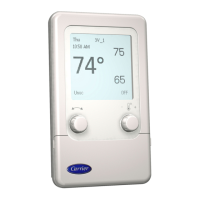
